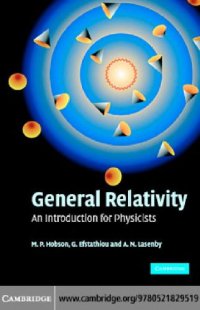
Ebook: General Relativity: An Introduction for Physicists
- Genre: Physics // Theory of Relativity and Gravitation
- Year: 2005
- Publisher: Cambridge University Press
- Language: English
- djvu
I was the TA for an undergraduate course that used this book. I read the book to reference equations when writing up homework solutions, and in response to students questions about it, but not otherwise. That is, I did not read it cover to cover, but selectively. However, almost invariably when I read a section I would think that something in it was either confusingly presented or simply wrong. I kept a list of my "grievances" as the semester went along, and I am writing them as part of this review. I probably should give the book one star, based on my experience, but since I haven't read very much of it, it's conceivable that other parts are very good. (So, it gets two stars.) Also note that the students uniformly complained about the book.1. P. 10, treatment of length contraction. The equation for length contraction is "derived" with no discussion of simultaneity. Essentially, the book writes dx = gamma ( dx - v dt ), and sets dt=0 so that dx is "length". This is not a correct derivation without more explanation, because (for example) using the inverse Lorentz transformation would give the opposite answer. None of the words in the book explain why the the Lorentz rather than inverse Lorentz transformation should be used. It's just not possible to give a correct treatment of Lorentz contraction without being careful about the notion of simulteneity. (It also would help to have a spacetime diagram.) You need to say what length means in each frame, and then compare them. This came up because I was giving students very little credit on a homework problem that was essentially "derive length contraction", and it turned out they had copied out of the book.2. P18,p117, notation for three-velocity. The book adopts the totally absurd convention of denoting the three velocity by vec{u} and the four-velocity by u^alpha. Of course, the three-velocity is not equal to the spatial components of the four-velocity, so this notation is incredibly confusing (if not inconsistent, since u^1 would denote both the 1 component of u^alpha and of vec{u}). A veteran of relativity can follow even an inconsistent notation, but this is incredibly confusing for somebody trying to learn the subject (which is the point of the book). I got lots of confused questions from students about this one, and no surprise. There are plenty of letters in the alphabet--choose a different one for the three-velocity!3. p120, second paragraph. This one is so ridiculous I can't believe it made it past the first reprinting. The authors write, "So far, we have not mentioned the frequency (or energy) of the photon, which characterises it in much the same way as the rest mass m_0 characterises a massive particle." This is of course completely false. The rest mass is an invariant quantity, whereas the frequency/energy depends on the frame. The analog of the rest mass for photons is zero, the invariant quantity of zero rest mass. The analog of photon energy is particle energy. Frequency has to do with quantum mechanics and has no analog I'm aware. This sentence sticks out like a sore thumb to anybody who has done some special relativistic kinematics. Again, I simply can't believe it wasn't caught as a mistake by the reprinting.4. p21, discussion of uniform acceleration. This is a more minor point, but I don't think the authors do a good job of explaining the concept of "uniform acceleration". Uniform acceleration usually does me "uniform four-force", which is very confusing terminology. I think the authors could do a better job of pointing this out. Let me emphasize that this point is minor in comparison with the others5. p123. The authors say that free particles move on "non-null" worldlines, rather than on "timelike worldlines". Again, this sticks out like a sore thumb; it should have been caught and fixed.6. p183 and elsewhere. The authors write R^{mu}_{nu} instead of START TRANSACTION WITH CONSISTENT SNAPSHOT; /* 2057 = bcc77f1da07ec714de0e8b19c5f32a56
Download the book General Relativity: An Introduction for Physicists for free or read online
Continue reading on any device:

Last viewed books
Related books
{related-news}
Comments (0)